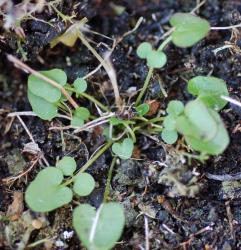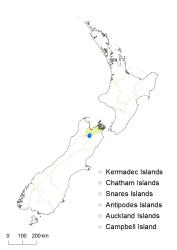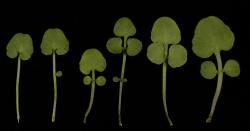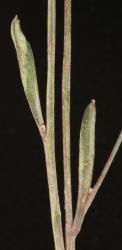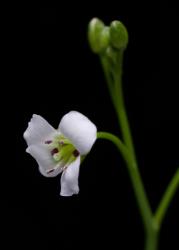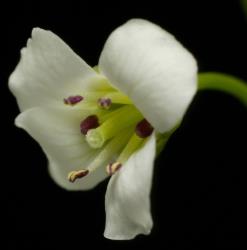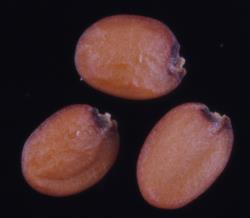Perennial herb, single rosette or with lateral branches. Leaves up to 50 mm long, simple or pinnatisect; lamina 2.0–21.0 × 2.5–13.0 mm, green, matt, membranous to semi-coriaceous, glabrous or with a sparsely hairy margin; petiole up to 32 mm long. Terminal pinna 2.0–12.0 × 2.5–13.0 mm, orbicular-pandurate, weakly pandurate to obovate-rhomboid; margin entire, with 2–4 indistinct hydathodes; apex obtuse to retuse, with an indistinct hydathode; base obtuse, truncate or cordate. Lateral pinnae 1–4 or absent, 0.5–6.0 × 0.5–7.0 mm, orbicular to broadly elliptic-orbicular; apex obtuse; base obtuse, truncate or cordate; petiolule 0.2–1.5 mm long. Cauline leaves narrower than rosette leaves, terminal and lateral pinnae up to 13 mm long, up to 1.5 mm wide, base attenuate. Inflorescence racemose, each raceme 3–10-flowered; peduncle up to 180 mm long, 0.5–1.4 mm diam. at base, ascending to erect, glabrous. Pedicels 9.0–14.0 mm long, 0.3–0.5 mm diam., glabrous. Sepals 2.2–2.7 × 1.0–1.7 mm, elliptic-oblong to broadly elliptic-obovate, saccate, green, glabrous, margin white and membranous, apex obtuse, base truncate. Petals 4.2–6.5 × 2.2–3.9 mm, white, limb obovate; apex obtuse; base attenuate to cuneate, tapering to a 0.5–1.0 mm long claw. Stamens 6; median filaments 4, 3.4–4.0 mm long; lateral filaments 2, 1.8–3.2 mm long; anthers 0.5–0.6 mm long, maroon, when dehiscent held at a similar height to or slightly below the stigma. Ovary 3.0–5.2 mm long, 0.5–0.6 mm diam., ± terete, green, glabrous; ovules 15–19; style 0.4–0.5 mm long, ± terete; stigma c. 0.4 mm diam. Siliques 17.0–26.0 × 0.9–1.2 mm, glabrous, style 0.4–0.6 mm long; valves purple-brown to purple-green at maturity and when dehiscent; replum 0.4–0.5 mm wide. Seeds 0.8–1.2 mm long, 0.6–0.9 mm wide, 0.3–0.4 mm thick, broadly oblong to oblong-orbicular, henna-green to henna; wing absent.
Cardamine dactyloides is distinguished from C. porphyroneura by its smaller growth habit and leaves, cauline leaves with narrow pinnae, petals broader, anthers violet, seeds broader and slightly larger, and the cotyledons of the seed embryo lacking violet-purple veins.
South Island: Sounds Nelson.
Cardamine dactyloides occurs on the ultramafic Red Hills in Sounds Nelson.
Cardamine dactyloides occurs on ultramafic rock outcrops in tussockland, open herbfield and beech (Fuscospora spp., Nothofagaceae) forest, where it usually grows on shaded ledges and crevices.
Cardamine dactyloides is assessed as having a conservation status of Threatened, Nationally Critical A(3) (de Lange et al. 2018).
Flowering October–December; Fruiting October–February.



